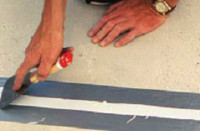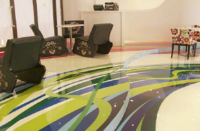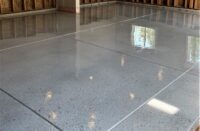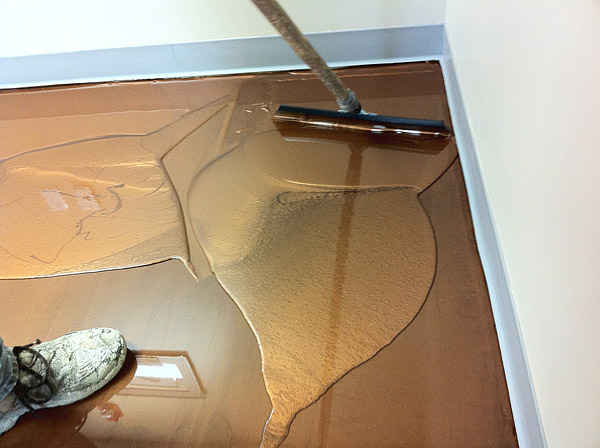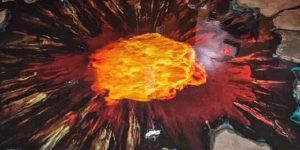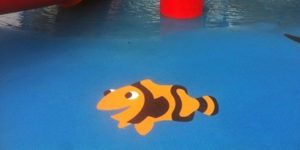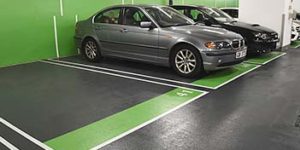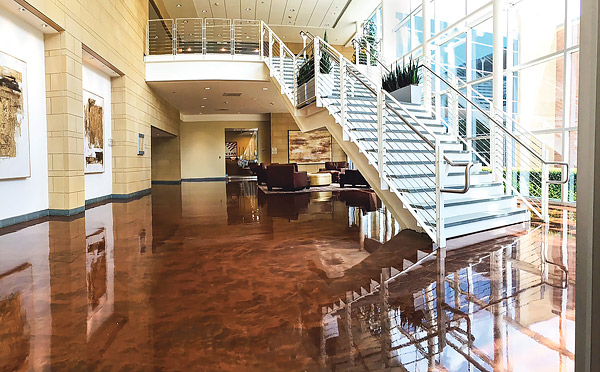
From commercial kitchens, fire stations, spas and salons to basements, garages, veterinarian clinics and airport hangars, epoxy materials are being applied to concrete floor surfaces. The reasons why are simple: Epoxies are easy to use, durable and profitable. And, new products are more environmentally friendly.
“Epoxies are time-tested, affordable, reliable floor coating solutions,” says David Brown, business development manager for Seal-Krete. When used on concrete surfaces, epoxies can turn the ordinary and marred into extraordinary and flawless, and with the added benefit of giving an appearance of depth to a space.
“By adding multiple colors to the floor at the same time, the results can be one of a kind,” notes Michael Jensen, president of Atlanta Concrete Artist.
“On concrete surfaces, epoxies provide a smooth base and hide imperfections,” says Ernie Archuleta, technical services manager for Rhino Linings Corp.’s Concrete Solutions product line.
Durability
Bryan Mercado, general manager of A Seamless Floor Co., specializes in decorative concrete overlays and designer epoxy floors. “About 80 percent of our jobs are tearing up existing interior flooring and laying down new surfaces,” he says. “After laying down concrete, I can color, stain or seal the surface with various epoxy systems and create detailed, professional work.”
Epoxy customers use the material in several ways. According to Brown, his company’s customers often use epoxy materials as a build coat to repair damaged floors and as a floor leveler. “Epoxy also has excellent adhesion properties along with great impact resistance, so it makes for a durable long-lasting floor coating,” he adds.
Archuleta says his company’s epoxies are excellent primers for urethane topcoats and are often used in their Quartz Flooring System, which is growing in popularity. Rhino Linings Corp. recommends a urethane topcoat for additional ultraviolet (UV) stability and chemical resistance.
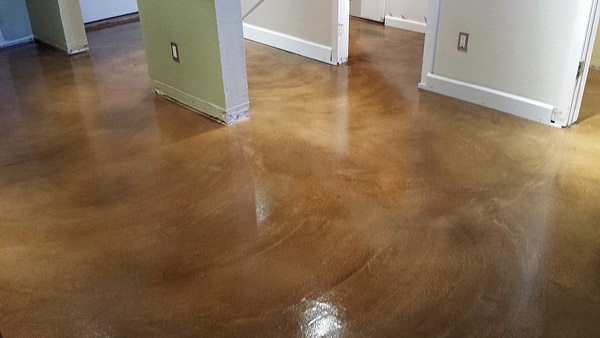
Paul Koury, president of Westcoat Specialty Coating Systems, says customers use his company’s clear epoxies such as EC-32 High Build Epoxy Clear Topcoat to protect interior concrete floors and Westcoat’s Texture-Crete interior system.
What about water-based versus solvent-based epoxies? It depends on the job, says Jensen. “We prefer water-based epoxies for interior residential applications because of the low odor and solvent-based epoxies for commercial applications because of their added abrasion resistance.”
Archuleta says water-based epoxies do not hide surface blemishes as well as Rhino Linings’ regular epoxies do, but its water-based products are a quick and inexpensive way to change the color and look of existing concrete.
In fact, he says the company’s WB Epoxy Clear and WB Epoxy Color products perform even better with WB Urethane, its water-based topcoat. “The topcoat adds additional chemical and abrasion resistance, but the products work very well on their own also.”
Westcoat’s EC-11 Water-Based Epoxy had been designed to be a pigmented primer and topcoat for fast turnaround when a low-odor epoxy is needed. However, the clear version has become the standard topcoat/sealer for many of the company’s systems, including its Fast Stain Grind & Seal, says Koury.
Increte recently reformulated its products to provide more resistance to ambering, and to reduce the chance of fish eyes (voids also referred to as bug holes) and amine blush (a whitish waxy residue). Rich Cofoid says his company is continuously researching and developing the newest technology to ensure state-of-the-art decorative products.
“The market demands outdoor areas be as pretty as indoors have been,” says Cofoid, who is Euclid Chemical’s project manager for its Increte brand of decorative concrete products.
Profitability
Versatile Building Products is well known in the market for its Roll on Rock garage floor epoxy system, according to Matthew Newman, company president. The products make garage floors easy to clean and maintain, enhance lighting, and are stain-proof, chemical-resistant and UV-tolerant.
Also popular for Versatile are 4195 Epoxy Primer, which dries quickly and is resistant to moisture, and 5073 Polyurea Top Coat, which also dries fast, is easy to apply and has a long pot life.
Concrete Solutions by Rhino Linings’ most popular epoxy coating systems are its Metal Fusion, Color Flake and Quartz systems. “Our Epoxy 200 is an excellent primer,” Archuleta adds. “It is a slow-drying, penetrating epoxy that repels moisture coming through a slab.”
Brown notes that his company’s 100 percent solids epoxy — Epoxy-Shell 1000 — is its most popular coating because of its versatility. It’s used for solid color, quartz, flake and metallic floors.
Westcoat’s Koury says his company offers more than 15 resinous flooring system-based solutions, with EC-11 being the most popular for sealing interior concrete and EC-32 at the top of the list for its versatility and superior clarity.
“We offer our customers a comprehensive line of supportive tools, such as detailed instructions in our system specifications, architectural drawings, training videos and the highest level of customer service,” Koury says.
Euclid Chemical also offers training sessions in decorative concrete conducted by Cofoid. “We’ve found that bringing the how-tos to the customers and giving them hands-on training is invaluable,” he says. “It’s an extra service we believe benefits everyone from property owners to contractors to the concrete industry itself.”
Environmentally safe
Less than a year ago, Versatile developed Eco Concrete Profiler, a safe and environmentally friendly concrete profiler and cleaner that’s noncorrosive and 100 percent biodegradable.
“Our advanced formula incorporates a proprietary blend of surfactants, organic minerals for the most effective concrete etching solution available,” says Newman. “It does not contain phosphoric, hydrochloric or muriatic acid, yet works better — and it’s safer.”
Seal-Krete recently developed two water-based epoxies in response to the federal regulatory focus on low volatile organic compounds (VOCs). “We’ve stepped up to offer our customers a true replacement to 100 percent solids epoxy,” Brown says. “Epoxy-Shell WB 250 and WB 50 are water-based epoxies built on the technology that made the 100 percent solids epoxies so reliable and less prone to failure.”
These lower-priced products offer quicker dry times, water clean-up and increased breathability, which reduces blistering and peeling.
Overall, Archuleta says epoxies are easy to clean, sanitary and monolithic, which is required in restaurants and hospitals.
Words to the wise
Two vital components of any successful concrete and epoxy floor job are meticulous slab preparation and carefully following material directions. Cofoid calls these “epoxy fundamentals” in his training sessions.
Too much moisture or vapor and epoxy coatings may not bond to the floor, so Cofoid suggests always performing a recognized moisture test before starting any job. Then, mitigate any excess moisture by improving drainage in the area, using a densifier and then retesting, using a moisture barrier engineered for epoxy floors, or using a moisture-tolerant epoxy.
The pH level of a floor also affects job success. Cofoid says epoxies are “fairly tolerant” of pH levels, but some urethanes and polyaspartics are not. He suggests performing a standard pH pencil test on the flooring surface using any inexpensive kit found online.
Simply wet a small area of the floor with distilled water, then draw a line in the area with the kit’s pencil or marker. Wait 15 to 30 seconds to see what color the line turns. Match that color to the kit’s color-coded pH scale key to determine the floor’s pH level, on a scale of 0 (white) to 14 (blue), with 0-7 being acid and 7-14 being alkaline.
Cofoid says most cured concrete will fall between eight and 10, but freshly poured concrete can be in the 13 range. “I believe most coatings require less than 10 on the scale,” to bond properly, he says. To be on the safe side, installers should consult with the manufacturer for product specifics.
Next, profile the slab mechanically. Jensen’s rule of thumb is: When in doubt, grind. “We grind every floor that we are planning on applying epoxy to,” he says. “This ensures that the concrete surface has been opened.”
Lastly, repair any cracks in the surface and clean it well.
According to Cofoid, a successful finished surface also requires strict adherence to the product manufacturer’s directions on first mixing — before combining — part A and part B separately, mixing the combination the appropriate amount of time, and doing all this within the correct pot life timeframe and specified work area temperature. Deviations from the requirements could not only result in a poor quality finished surface, but could result in personal injuries, Cofoid says.
Solvent-based epoxies, for example, have a low flash point and strong fumes. Keep these materials away from pilot lights and gas heaters and properly ventilate the work space, he adds.
“We believe quality work the first time, every time, will spread awareness of the benefits of concrete and epoxy flooring when compared to the conventional alternatives, such as carpet, tile and wood,” says Mercado. “So whatever it takes to safely create the best product possible, we will do.”
www.asfcompany.com
www.atlantaconcreteartist.com
www.increte.com
www.rhinolinings.com
www.seal-kretehp.com
www.versatilebuildingproducts.com
www.westcoat.com
